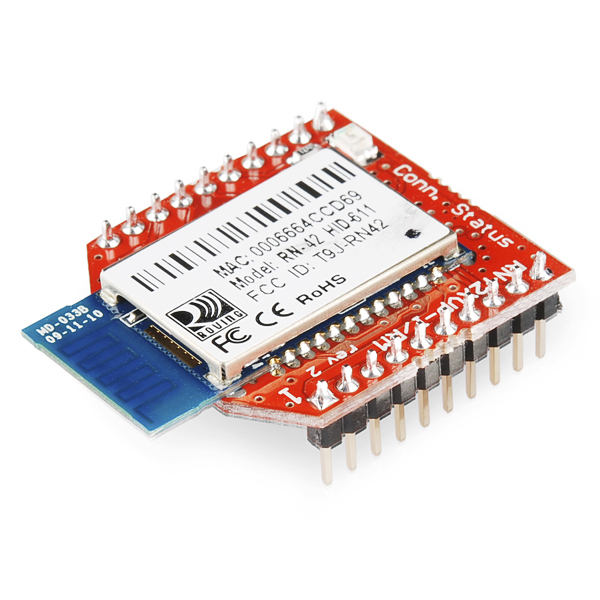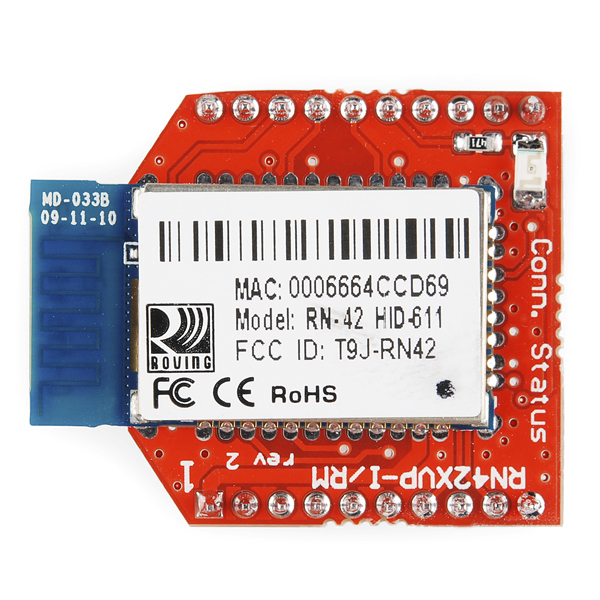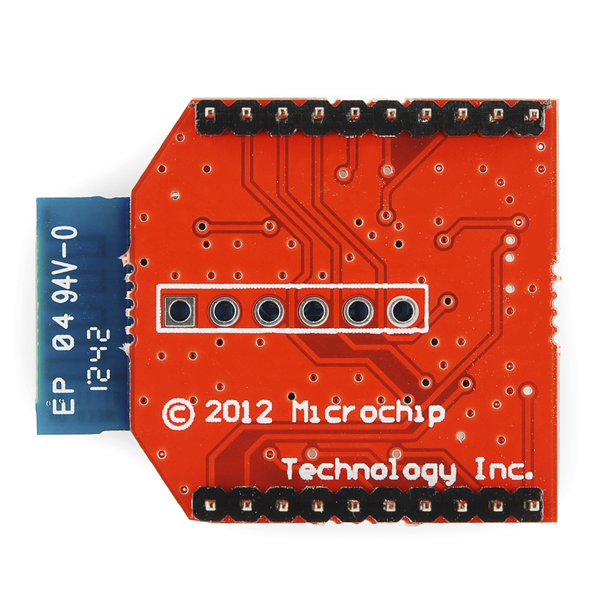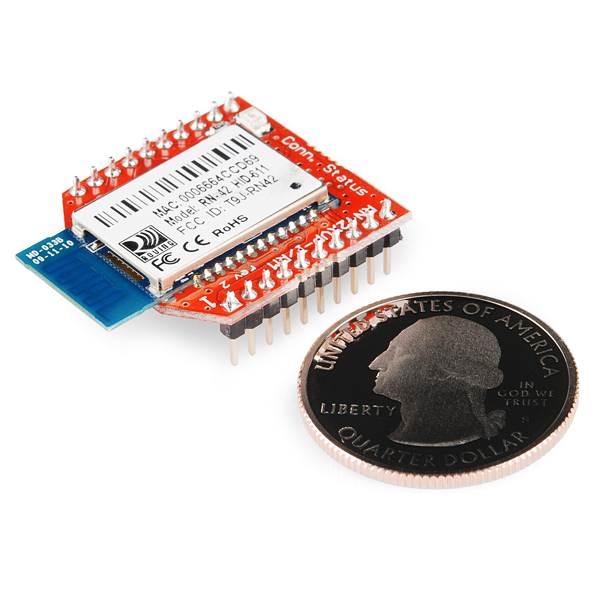RN42-XV Bluetooth Module - PCB Antenna
So it turns out that your XBee based device would work even better as a Bluetooth device... that probably means back to the drawing board, right? Well not anymore! Now you can swap in Bluetooth functionality without a major hardware redesign!
The RN42XV is a small form factor, low power Bluetooth radio module offering plug-in compatibility for the widely used 2 x 10 (2mm) socket typically used for 802.15.4 radio modules. Based on the popular 2 x 10 (2mm) socket footprint often found in embedded applications, the Roving Networks’ RN42XV module provides Bluetooth connectivity in legacy and existing designs that may have been based upon the 802.15.4 standard.
The RN42XV Class 2 Bluetooth module is based on the RN42. This module supports multiple interface protocols, is simple to design in, and is fully certified, making it a complete embedded Bluetooth solution. With its high-performance, on-chip antenna and support for Bluetooth EDR, the RN42 delivers up to a 3 Mbps data rate for distances up to 20 meters.
- Fully certified Bluetooth® version 2.1 module, supports version 2.1 + Enhanced Data Rate (EDR)
- Backwards-compatible with Bluetooth version 2.0, 1.2, and 1.1
- Pin compatible with widely used 2 x 10 2-mm socket typically used for 802.15.4 applications
- Low power: 26 uA sleep, 3 mA connected, 30 mA transmit
- UART (SPP or HCI) and USB (HCI only) data connection interfaces
- Sustained SPP data rates: 240 Kbps (slave), 300 Kbps (master)
- Embedded Bluetooth stack profiles included (requires no host stack): GAP, SDP, RFCOMM, and L2CAP protocols, with SPP, HID and DUN profile support
- Bluetooth SIG certified
- Certifications: FCC, IC, CE
- PCB trace antenna
RN42-XV Bluetooth Module - PCB Antenna Product Help and Resources
Using the BlueSMiRF
September 16, 2013
How to get started using the BlueSMiRF and Bluetooth Mate Silvers.
Comments
Looking for answers to technical questions?
We welcome your comments and suggestions below. However, if you are looking for solutions to technical questions please see our Technical Assistance page.
Customer Reviews
4 out of 5
Based on 1 ratings:
RN42-XV Bluetooth Module - OK !
It is an easy module to use and program with Arduino. Great for school projects. Gerry





-------------------- Tech Support Tips/Troubleshooting/Common Issues --------------------
RN42-XV's Firmware
As of 10/3/2016, I just tested the firmware on one of the RN42-XVs from our storefront. While the firmware on the RN42-XV is v6.30, there are no links that provide firmware updates or methods to roll back to other firmware versions using the "Microchip DFU Utility" as stated in this release note [ http://ww1.microchip.com/downloads/en/DeviceDoc/RN41&RN42v6.30_release_notes.pdf ]. Additionally, the RN-42s on the BlueSMiRF Silver and Bluetooth Mate Silver is still v6.15 because we specifically order it as v6.15.
Has any one tried using the RN42/41 as HID digitizer. if so please share the data format I should send to RN42. Many Thanks John
looks like an awesome wireless solution for the price! cant wait to move mine from the wishlist to the cart!
Will this work with the seeed studio xbee shield? (it has the same form factor)
Every "xbee form factor" module should work with every Xbee Shield.
Would I be able to stream audio through this?
Does this product have headers preinstalled?
yes
TS note: Table 2-8 is the datasheet is in error. I have measured a board from our inventory and pins 4 and 18 are not the same circuit. Pin 4 is GPIO10, and Pin 18 is GPIO7 per Figure 3-1.
I have put up a tutorial on setting up the RN-42XV bluetooth module for serial communication with the FioV3 board at http://www.forward.com.au/pfod/ArduinoProgramming/FioV3/index.html
I want to remote program an Fio board with the RN42 Bluetooth module but I can't have the DTR signal driven to remotely reset the board. I pulled low pins UART_CTS, DCD (PIO3), DSR (PIO6) and CTS (PIO7). The only profile that seems to drive remote DTR & RTS is MDM SPP (the Roving networks datasheet states that profiles DUN should also drive them but I can't see that). But with the MDM SPP profile, the device is automatically recognized as a keyboard which prevents use of the terminal or the Arduino IDE. Can anybody help ?
It was an issue with firmware 6.11, latest firmware 6.15 solves it. * Check Bluetooth Firmware Ver. 6.15 Release Notes on the Microchip's site for an explanation. * Automatic Over-The-Air Programming is now solved on The AirBoard new design!
I've been reading and rereading articles for weeks now and I still can't figure out this issue. Why is it that even if you get a Bluetooth module with an HID profile stack (eg the RN42-XV Bluetooth Module) the only way you can communicate to android is through another app? My initial project is to make a simple push button send a single keyboard key press to a text editor without any additional fluff. The thing that gets me is you can buy countless bluetooth keyboards that function right out of the box as keyboards and by default the RN42-XV is configured to be a keyboard but it still doesn't work as seamlessly. I don't have enough knowledge with android to make an app. If any one has any advice on this I'd greatly appreciate it.
I'm interested in the same question. Someone..?
I realize your question is somewhat old, but for what it's worth, you could try RedBearLab's BLE shield (http://redbearlab.com/bleshield/). I just got one and hooked it up using the sample sketch. It worked well out of the box, although the iOS app they publish (mostly as a demo) is quite simplistic. I'm now learning to build a custom iOS app to communicate with it.
I overlooked this myself when purchasing this item but it does not fit on the standard bread board purchased from this site. You'll have to wrap wires around the pins to plug it into the board.
SparkFun also sells a breakout board for this: https://www.sparkfun.com/products/8276 (make sure you get two of the headers as well).
Links to tutorials for configuring the module: http://ww1.microchip.com/downloads/en/DeviceDoc/RN-HID-User%20Guide-1.1r.pdf http://ftp.rovingnetworks.com/Graphics/Erica/Documentation/presentations/bluetooth%20training/ I used the XBee Explorer Dongle to connect it to the pc with the X-CTU software.
What regulated 3.3v breadboard compatible breakout board can I use this with?
"Pin compatible with widely used 2 x 10 2-mm socket typically used for 802.15.4 applications"
Would a xbee breakout board work properly?
Can I use this in a LilyPad Xbee? Bluetooth on a LilyPad would be great.
Do i need to ground unused pins? Currently I am only using Vcc, Tx, RX, and Gnd. I am planning on making a pcb with this part.
where can I find a users guide for this module?
Check out the "Documentation and Software" section of this page: http://www.microchip.com/wwwproducts/Devices.aspx?dDocName=en560176
Can someone here confirm whether this has the HID profile baked in? It says "with HID profile support", but does that mean it can be switched between say SPP and HID like product WRL-10823? Thanks!
I just powered my up and it appeared as a keyboard. I sent the "S~,0" command to revert to SPP and it now appears as "Other". This would seem to indicate it has HID firmware installed and that HID mode is default.
Thank you so much. Since the Microchip site for this module linked to the HID profile user guide, I was hoping this to be the case :) Time to go tweak the design of my iPad keyfob remote control!